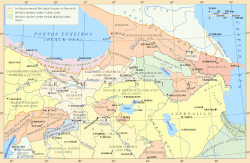Saltukids
 From Wikipedia - Reading time: 15 min
From Wikipedia - Reading time: 15 min
Saltukids | |
|---|---|
| 1071–1202 | |
 Map of the Saltukids ( ) | |
| Capital | Erzurum |
| Common languages | Turkish , Western Armenian |
| Government | Monarchy |
| History | |
• Established | 1071 |
• Disestablished | 1202 |
The Saltukids or Saltuqids (Modern Turkish: Saltuklu Beyliği) were a dynasty ruling one of the Anatolian beyliks of the Seljuk Empire, founded after the Battle of Manzikert (1071) and centered on Erzurum. The Saltukids ruled between 1071 and 1202. The beylik was founded by Emir Saltuk, one of the Turkmen[1] commanders of the Great Seljuk Alp Arslan. The beylik fought frequently against the Georgian Kingdom for hegemony of the Kars region. The center of the beylik, Erzurum, was briefly re-occupied by the Byzantine Empire between 1077 and 1079, and was besieged by the Georgian King Giorgi III in 1184. It comprised the entirety of present-day Erzurum and Bayburt provinces, lands east of Erzincan, most of Kars, and lands north of Ağrı and Muş provinces during its height.
Origin
[edit]
The first known Saltukid is Ali, who was ruler of Erzurum in 1103. His son and successor was Saltuk, who succeeded him sometime after 1123. Saltuk had a female relative, a daughter or sister, who married Shah-i- Armind of Akhlat, Sukman II.[2]
In 1132, Ali's son Izz al-Din Saltuk became malik.[3] Izz al-Din was defeated captured in 1154 by Georgians, led by Dimitri I.[3] He would be ransomed by Sökmen of the Artuqids, who later married a daughter of Izz al-Din.[3] In 1161, Izz al-Din along with other Turkish allies besieged the Georgians at Ani, but was defeated.[3] He sent a daughter to marry Kilij Arslan II, but she was captured by the Danishmendid Yağıbasan and married off to his nephew.[3]
The Saltukid dynasty is also notable for having a woman, Melike Mama Hatun, sister of Nasiruddin Muhammed, directly administering its realm for an estimated nine years, between 1191 and 1200. She was later dethroned by the Beys and replaced by her son Malik-Shah once she had started searching for a husband among the Mamluk nobility. Mama Hatun built an impressive caravanserai in the town of Tercan, where her mausoleum also stands. Tercan itself used to be called "Mamahatun", and is sometimes still called as such locally.

At one point, the son of Muhammad b. Saltuq II offered to convert to Christianity in order to marry the Georgian Queen Tamar.[5]
The name of the ruling dynasty of the beylik should not be confused with that of Sarı Saltuk, a Turkish mystic and saint; who is of later date, more associated with western Anatolia and the Balkans (especially Dobruja), and to whom the epic Saltuknâme is dedicated.
The last ruler of the Saltukids, Alaeddin Muhammed, was dethroned and imprisoned by the Sultan of Rum Süleymanshah II during Süleymanshah's Georgian rout in 1202, and the Saltukid beylik was subsequently annexed by the Sultanate of Rum.[1] During 30 years after this conquest, the region of Erzurum was then ruled by the two Seljuq princes Tughril ibn Kılıç Arslan II and his son Jahan Shah bin Tughril as an appanage, before being incorporated into the Sultanate of Rum under Kay Qubadh I in 627/1230.[5]
Architecture
[edit]The beys of Saltuk left important works of architecture such as the Tepsi Minare in Erzurum and the caravanserai in Mama Hatun.[3]
Rulers
[edit]- Saltuk I (1071–1102)
- Ali (1102–1124)
- Muzaffer Gazi (1124–1132)
- Izzeddin Saltuk II (1132–1168)
- Nasiruddin Muhammed (1168–1191)
- Melike Mama Hatun (1191–1200)
- Alaeddin Muhammed (1200–1202)
Notes
[edit]| History of the Turkic peoples pre–14th century |
|---|
 |
- ^ a b Bosworth 1996, p. 218.
- ^ Cahen 1968, p. 106-107.
- ^ a b c d e f Leiser 1995, p. 1001.
- ^ "Copper alloy fals of Muhammad b. Salduq/Tughril Beg, Rukh al-Din Abu Talib, Erzurum/Arzarum, 574 H. 1917.216.762". numismatics.org. American Numismatic Society.
- ^ a b Bosworth 1996, p. 218 Quote: "The Saltuqids' main role in the political and military affairs of the time was in warfare with the Georgians, expanding southwards from the time of their king David the Restorer (1089–1125), often as allies of the Shah-i Armanids (see above, no. 97); but in a curious episode, Muhammad b. Saltuq II's son offered to convert to Christianity in order to marry the celebrated Queen T'amar of Georgia. The last years of the family are unclear, but in 598/1202 the Rum Seljuq Sulayman II, while en route for a campaign against the Georgians, put an end to the Saltuqids; and for some thirty years after this, Erzurum was to be ruled by two Seljuq princes as an appanage before Kay Qubadh I in 627/1230 incorporated it into his sultanate."
References
[edit]- Bosworth, Clifford Edmund (1996). The New Islamic Dynasties: A Chronological and Genealogical Manual. Edinburgh University Press. ISBN 0-7486-2137-7.
- Mustafa Güler, İlknur Aktuğ Kolay. "12. yüzyıl Anadolu Türk Camileri" [12th century Turkish mosques in Anatolia] (PDF) (in Turkish). Istanbul Technical University Magazine (İtüdergi). Archived from the original (PDF) on 2007-07-04.
- (Book cover) Oktay Aslanapa (1991). Anadolu'da ilk Türk mimarisi: Başlangıcı ve gelişmesi [Early Turkish architecture in Anatolia: Beginnings and development] (in Turkish). AKM Publications, Ankara. ISBN 975-16-0264-5.
- Cahen, Claude (1968). Pre-Ottoman Turkey: A General Survey of the Material and Spiritual Culture and History C. 1071-1330. Sidgwick and Jackson.
- Leiser, G. (1995). "Saltuk Oghullari". In Bosworth, C.E.; Van Donzel, E.; Heinrichs, W.P.; Lecomte, G. (eds.). The Encyclopaedia of Islam. Vol. VIII:Ned-Sam. E.J. Brill.
External links
[edit]- "Üç Kümbetler (Three tombs) or Emir Saltuk Tomb, Erzurum". ArchNet. Archived from the original on 2011-02-23.
- "Great Mosque (Ulu Cami) of Erzurum". ArchNet. Archived from the original on 2005-12-19.
- "Mama Hatun Caravanserai, Tercan". ArchNet.
- "Mama Hatun Tomb, Tercan". ArchNet.
 KSF
KSF
